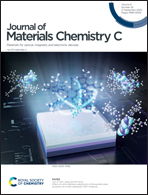An efficient and stable fluorescent sensor based on APTES-functionalized CsPbBr3 perovskite quantum dots for ultrasensitive tetracycline detection in ethanol†
Abstract
In recent years, all-inorganic halide perovskite quantum dots (IPQDs) have received a lot of attention as a new fluorescent material with excellent fluorescence properties. But their instability in polar solvents is the major factor that obstructs their applications in analysis. In this work, a novel fluorescent sensor was simply synthesized by room temperature synthesis for the detection of tetracycline (TC) in highly polar ethanol. At room temperature, a silicon layer was easily modified by in situ hydrolysis of 3-aminopropyltriethoxysilane (APTES) on the surface of IPQDs to synthesize a new type of fluorescent sensor without adding water or an initiator, which can be stably present in ethanol. The novel method has shown high selectivity and sensitivity to TC in ethanol, and the detection limit can even reach 76 nM. The mechanism of fluorescence quenching is mainly the electron transfer between TC and IPQDs. Furthermore, the sensor was successfully applied to the detection of trace TC in actual samples. Our research has laid the foundation for improving the stability of perovskite quantum dots and their development in the field of analytical chemistry.



 Please wait while we load your content...
Please wait while we load your content...